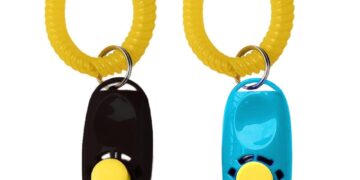Table of Contents
Introduction: The Snap That Changed Everything
The sound is seared into my memory.
Not a tear, not a rip, but a sharp, crystalline crack.
One moment, I was holding the leash connecting me to Cooper, my 75-pound Labrador Retriever, a solid mass of muscle and boundless joy.
The next, my hand was holding nothing but a useless nylon strap, its heavy-duty metal clip sheared in two.
Cooper, propelled by the explosive energy of a squirrel-sighting, was now a blur of yellow fur bolting toward a busy road.
The seconds that followed were a cold, slow-motion nightmare.
The frantic shouting of his name, the screech of tires, the heart-stopping fear that paralyzes every muscle.
By some miracle, a driver saw him in time.
Cooper, startled by the noise, veered back toward me, his adventure forgotten.
But for me, the walk—and my entire understanding of the equipment I trusted—was shattered.
That moment of sheer terror was not a training failure.
Cooper was being a dog, a powerful, exuberant Labrador doing what his instincts screamed at him to do.1
The failure was in my hands.
It was an
engineering failure.
The “heavy-duty” leash I had purchased, the one that looked and felt substantial, had failed catastrophically at the most critical moment.
This experience sent me down a rabbit hole, not just as a dog owner, but as a canine behaviorist and gear analyst.
I discovered that the pet product industry has, with the best of intentions, sold us a dangerous lie: the idea that vague terms like “strong” or “durable” are a meaningful guarantee of safety.
This report is the culmination of that journey.
It is an argument that choosing a leash for a powerful dog like a Labrador is not about picking a pet accessory from a colorful wall display.
It is about understanding and building a high-force safety system.
The terror and guilt of nearly losing my best friend forced me to question everything, and in the process, I found answers not in the pet store, but in the unforgiving worlds of rock climbing and high-performance sailing—places where equipment failure is not an option.
Chapter 1: The Great Leash Deception—Why We’ve All Been Choosing Wrong
The walk home after Cooper’s near-miss was silent and heavy.
I kept looking at the two pieces of the broken clip in my pocket.
How could something that felt so solid break so easily? The answer, I soon learned, lies in a systemic market failure that leaves owners of large, powerful breeds dangerously underserved.
We are choosing the wrong equipment because we are being sold the wrong ideas.
Deconstructing “Pet-Grade” Standards
Walk into any pet supply store, and you’ll be faced with an array of leashes adorned with reassuring but ultimately hollow marketing terms: “heavy-duty,” “durable,” “built for strong dogs”.3
These words create a powerful illusion of safety.
The problem is that “strong” is not a standard; it is a marketing adjective.
Without quantifiable data—such as a certified breaking strength or a safe working load—these terms are meaningless.3
The vast majority of pet products are designed for the mass market, which means they are optimized for small-to-medium-sized dogs or large dogs that are placid walkers.
The forces generated by a 55 to 80-pound Labrador lunging unexpectedly are an extreme outlier for which this standard equipment is simply not engineered.5
This “good enough for most” manufacturing principle becomes a “catastrophically insufficient” reality for those of us at the higher end of the canine power spectrum.
We believe we are buying a product fit for our dog, but we are actually buying a product fit for the
average dog—a critical and dangerous distinction.
The Retractable Leash Fallacy
Nowhere is this disconnect more apparent than with the retractable leash.
Despite their popularity, these devices are fundamentally unsuitable and unsafe for a Labrador.
Their design actively undermines proper leash manners and introduces significant risks.
The core function of a retractable leash is to maintain constant tension.
For the dog to move forward and explore, it must pull, extending the line.7
This action is then rewarded when the dog reaches its goal—a fascinating smell, a patch of grass.
This creates a deeply confusing signal for the dog.
It teaches them that pulling is the key to freedom, directly contradicting everything we try to achieve in loose-leash training.7
From the dog’s perspective, they are constantly being pulled by their owner, which can intensify the natural “opposition reflex,” where a dog’s instinct is to pull against pressure.9
The safety hazards are even more alarming.
The thin cord can cause severe rope burns, lacerations, or even fractures and amputations if it wraps around a person’s finger or a dog’s leg during a sudden bolt.8
The locking mechanisms are notoriously unreliable and not designed to withstand the shock load of a large dog hitting the end of the line at full speed.11
A 15- or 20-foot head start allows a powerful dog to build up terrifying momentum, and when that force hits the plastic handle, the result can be a dropped leash, a broken internal mechanism, and a dog running free with a clattering plastic handle chasing it—a frightening experience that can make a bad situation worse.8
The Hidden Crisis of Hardware Failure
In my investigation, I discovered a crucial truth: the leash material itself, whether nylon or leather, is rarely the point of failure.
The catastrophic break almost always occurs at the metal hardware—the clip that attaches the leash to the collar or harness.4
This was exactly what happened with Cooper.
The nylon webbing was perfectly intact; the metal clip had failed.
These clips are the system’s weakest link.
Many are made from cheap zinc alloy, sometimes called “pot metal,” which is brittle and prone to developing micro-fractures that can lead to sudden, unexpected failure under stress.3
Others use internal springs for the bolt-snap mechanism, which can wear out, rust, or become compromised by sand and dirt, preventing a secure closure.4
The average owner has no way of knowing the quality or true strength of this single, critical point of connection.
We are asked to place our absolute trust—and our dog’s life—in a piece of unrated, untested, and often woefully inadequate hardware.14
Chapter 2: The Climber’s Epiphany—A New Paradigm for Safety and Control
My confidence was shattered.
If I couldn’t trust the very equipment designed for a dog of Cooper’s size and strength, what could I trust? My search for an answer led me away from the pet industry entirely and toward my other passions: rock climbing and sailing.
One afternoon, I sat on my garage floor with the pieces of Cooper’s broken leash clip in one hand and a climbing carabiner from my gear rack in the other.
The difference was not just in weight or feel; it was a difference in philosophy.
The leash clip was a consumer product, designed for convenience and appearance.
The carabiner was a piece of life-safety equipment, meticulously engineered and tested to withstand incredible forces, with its strength ratings stamped right into the metal.15
It was in that moment of comparison that the solution became clear.
I had been thinking about the problem all wrong.
Introducing the “Dynamic Safety System”
A walk with a Labrador is not a casual stroll.
It is an exercise in managing unpredictable, high-impact forces.
Therefore, the equipment we use must be modeled on systems designed for exactly that purpose.
This led me to develop a new framework: the Dynamic Safety System.
This paradigm reframes the entire dog-walking apparatus by breaking it down into three core components, each with a direct analog in the world of high-force sports.
- The Engine (The Dog): A Labrador is a powerful, unpredictable force generator. Like the wind in a sail or the gravity acting on a falling climber, this force is the primary input into the system. It must be understood and respected.
- The Transmission (The Leash): This is the component that connects the handler to the engine. Its job is not merely to tether, but to manage and absorb the forces generated by the engine. This is where the crucial distinction between a dynamic rope (which stretches to absorb shock) and a static rope (which does not) becomes the key to safety and comfort.17
- The Anchor (The Hardware): This represents the critical connection points in the system—the clip attaching the leash to the harness and the harness to the dog. These points must be absolutely fail-proof, engineered not for aesthetics but to withstand the peak loads the engine can generate. This is the world of load-rated carabiners and marine-grade shackles.16
Shifting the Mindset
This framework demands a fundamental shift in our thinking.
We must stop asking, “What’s a good leash for my Lab?” This question leads us back to the pet store aisle, to the world of subjective marketing and unverified claims.
Instead, we must start asking, “How do I build a safety system capable of managing the peak forces my Lab can generate?”
This new question forces us to think like engineers, not just consumers.
It compels us to demand data, to understand the principles of force and materials, and to assemble a system where every component is chosen for its specific, verifiable performance characteristics.
It moves us from a mindset of passive trust to one of active, informed safety design.
Chapter 3: Pillar I: The Engine—Understanding Labrador Force Dynamics
Before we can build a system to control a force, we must first understand the nature of that force.
A Labrador is not just a big dog; it is a purpose-built athlete, a product of generations of breeding for power, endurance, and a relentless work ethic.
Understanding the “engine” is the first and most critical step in designing our Dynamic Safety System.
The Labrador Profile
The modern Labrador Retriever’s story begins in Newfoundland, where its ancestors worked alongside fishermen, retrieving nets and escaped fish from the icy North Atlantic waters.5
This heritage forged a dog with a unique combination of traits: a powerful, athletic build weighing between 55 and 80 pounds; a deep chest and muscular frame built for endurance; and an innate love of retrieving and exploration.2
They are classified as a high-energy sporting breed, requiring a minimum of an hour of vigorous exercise each day, though many need closer to two hours to remain physically and mentally content.2
When this energy is not given a proper outlet, it can manifest in undesirable behaviors like destructiveness or hyperactivity—and most commonly, pulling on the leash.20
The Psychology of the Pull
It is a common misconception among frustrated owners that a pulling Labrador is being deliberately disobedient or “dominant.” While Labs are highly intelligent and famously eager to please, the act of pulling on a leash stems from a conflict between competing motivations, where powerful instincts often override learned behaviors.1
The pull is not driven by malice, but by a confluence of psychological and physiological factors.
- The Opposition Reflex: This is a dog’s natural, subconscious instinct to push or pull against pressure to maintain balance.9 When a dog pulls and feels the leash tighten, its reflex is to pull harder. When the owner responds by pulling back, a vicious cycle is created. The leash becomes a constant source of tension, communicating struggle rather than connection.9
- A History of Reward: From a dog’s perspective, pulling works. It achieves the desired outcome: reaching that fascinating smell, greeting another dog, or simply moving forward at a more exciting pace.22 Every time a dog pulls and the owner takes a step forward, the pulling behavior is reinforced. The environment itself—full of exciting sights, sounds, and smells—becomes a powerful reward that the dog learns to access through pulling.23
- Tension, Frustration, and Arousal: A constantly tight leash creates both physical and psychological stress. This restraint can lead to a state of frustration, which is a primary trigger for reactive behaviors like lunging and barking.10 The dog feels trapped and unable to naturally investigate or retreat from a stimulus, causing its arousal level to spike. In this state, the dog is not thinking or learning; it is simply reacting.25
Quantifying the Force
The most dangerous force a leash must handle is not a steady pull, but the sudden, explosive shock load of a lunge.
Imagine a 75-pound dog, at a standstill, launching forward with all its power.
The force generated in that split second is immense.
While it’s difficult to measure without specialized load cells, we can draw a parallel from the world of climbing.
A dynamic climbing rope is designed to handle the “impact force” of a fall—a sudden, high-energy event.
A Labrador’s lunge creates a similar shock load on the leash system.
This is not a gentle, steady pressure; it is a violent jerk that tests the absolute limit of every component, especially the hardware.
It is this peak force, not the average pulling tension, that our Dynamic Safety System must be engineered to withstand without fail.
Chapter 4: Pillar II: The Transmission—The Leash as a Force-Management Tool
With a clear understanding of the powerful “engine,” we can now focus on the “transmission”—the leash itself.
In our new paradigm, the leash is not a simple tether.
It is a sophisticated force-management tool.
Its primary job is to absorb and dissipate the shock load generated by the engine, protecting both the dog and the handler from injurious, high-impact jolts.
The key to this lies in the principles of dynamic and static ropes, borrowed directly from climbing.
The Climbing Rope Analogy Explained
In climbing, the choice between a dynamic and a static rope can be a matter of life and death.
This same principle, though less dramatic, applies directly to choosing a leash for a powerful dog.
- Static Leashes (Standard Nylon, Leather, Biothane): The vast majority of dog leashes on the market are functionally static. Like a static climbing rope used for hauling gear or rappelling, they are designed to have minimal stretch or elongation.17 When a Labrador lunges against a static leash, the force is transmitted almost instantaneously from the dog’s harness to the handler’s arm. This creates a high-impact, jarring shock. For the dog, this force is concentrated on its body and can lead to tracheal, neck, or spinal injuries, especially if connected to a collar.9 For the handler, it can cause injuries to the hand, wrist, elbow, or shoulder, and is a common cause of falls.28
- Dynamic Leashes (Bungee or Shock-Absorbing Leashes): These leashes incorporate an elasticized or bungee section, making them functionally dynamic. Like a dynamic climbing rope that stretches to absorb the energy of a fall, this elastic section elongates under a sudden load.18 This simple mechanical property has a profound effect: it dissipates the peak force of the lunge over a longer period. The sudden, violent
jerk is transformed into a progressive, manageable tension. This is the core principle of a safe “catch” in climbing, and it is the single most effective equipment-based solution for managing a lunging dog. It protects the dog’s body from sudden impact and gives the handler a crucial moment to brace and regain control, rather than being yanked off balance.
Material Science Deep Dive
While the dynamic property is paramount, the base material of the leash is still a critical consideration for durability, handling, and longevity.
Moving beyond the generic offerings, several high-performance materials are exceptionally well-suited for a Labrador’s leash.
- Military-Grade Nylon: It is essential to distinguish between the cheap, flat nylon found on budget leashes and true military-specification webbing. High-quality nylon leashes will often specify a high “denier” rating (e.g., 1000D), which indicates a thicker, more durable fiber.31 Look for reinforced stitching patterns like a “Box-X” or “bar-tack” at all stress points (the handle and the clip attachment), as these are far stronger than simple linear stitching.31 While incredibly strong and affordable, be aware that lower-quality nylon can be abrasive and cause “rope burn” on the handler’s hands.7
- Full-Grain Leather: A traditional choice for good reason, leather offers a unique combination of strength and comfort. Over time, a quality full-grain leather leash will soften and conform to the handler’s grip, becoming more comfortable with each use.7 It is extremely durable and less prone to causing friction burns than nylon. However, leather requires occasional cleaning and conditioning to maintain its strength and flexibility, and it can be heavier than synthetic alternatives, especially when wet.31
- Biothane: This modern composite material is a standout performer, especially for active dogs. Biothane consists of a polyester webbing core coated in PVC, creating a leash that is waterproof, odor-resistant, and exceptionally easy to clean.31 It offers a comfortable, slightly tacky grip that remains consistent even in wet or muddy conditions, and it is highly resistant to abrasion and chewing. It effectively combines the strength of nylon with even greater durability and lower maintenance than leather.31
- Climbing-Style Rope: Leashes constructed from kernmantle rope—the same design used for climbing ropes, with a strong inner core protected by a woven outer sheath—are another excellent option.26 This rounded construction is naturally comfortable in the hand, reducing the likelihood of burns. They are incredibly durable and often feature reflective tracers for visibility, a feature borrowed from static caving and rescue lines.26
Table 1: Leash Material Performance Matrix
To simplify the selection process, this table compares the key performance characteristics of these four premium materials.
| Material Type | Tensile Strength (General) | Wet Grip | Dry Grip | Abrasion Resistance | Maintenance | Best For… |
| Military-Grade Nylon | Very High | Fair | Good | Good | Low (Machine Washable) | All-purpose use, budget-conscious buyers needing high strength.31 |
| Full-Grain Leather | Very High | Poor | Excellent | Very Good | High (Requires Conditioning) | Handlers who prioritize comfort and a classic aesthetic; dry conditions.7 |
| Biothane | Excellent | Excellent | Excellent | Excellent | Very Low (Wipes Clean) | Wet/muddy environments, heavy-duty use, handlers wanting maximum durability with zero maintenance.31 |
| Climbing-Style Rope | Excellent | Good | Excellent | Excellent | Low | All-weather walking, handlers who prefer a comfortable, rounded grip.33 |
Chapter 5: Pillar III: The Anchor—Hardware, the Point of Catastrophic Failure
We now arrive at the most critical and most overlooked component of the system: the “anchor.” This is the hardware that connects the leash to the dog.
As my own terrifying experience with Cooper demonstrated, a leash made of the strongest material in the world is useless if the metal clip connecting it is not equal to the task.
This is where the gap between “pet-grade” and “life-safety” equipment becomes a chasm.
Life-Safety vs. Pet-Grade Hardware
In the worlds of climbing and sailing, hardware is governed by stringent international standards.
Lives depend on it.
- Climbing Carabiners: Every climbing carabiner is stamped with certifications from bodies like the CE (Conformité Européenne) or UIAA (International Climbing and Mountaineering Federation).15 These stamps are a guarantee that the carabiner has been tested to meet specific minimum strength requirements. These ratings are measured in kilonewtons (kN) and are displayed for three different load scenarios: along the major axis (lengthwise with the gate closed), along the minor axis (sideways), and with the gate open.16 A standard climbing carabiner is rated to at least 20 kN on its major axis, which translates to over 4,500 pounds of force.16
- Sailing Shackles: Marine hardware is similarly rated for extreme forces. Components are given a Breaking Strength (the absolute force at which it will fail) and a Safe Working Load (SWL), which is typically a fraction of the breaking strength and represents the maximum force the hardware should be subjected to in normal use.19 This hardware is designed to manage the immense and sustained tension from wind-filled sails, with breaking strengths often measured in thousands or tens of thousands of pounds.19
In stark contrast, the clips on dog leashes have no governing body, no required testing protocols, and no published strength ratings.3
They are a complete unknown.
An owner is forced to rely on visual appearance alone, which is a dangerously unreliable indicator of strength.
Hardware Autopsy: A Breakdown of Common Clips
To make an informed choice, it is vital to be able to identify different types of hardware and understand their inherent strengths and weaknesses.
- Standard Swivel Snap (Bolt Snap): This is the most ubiquitous clip on the market. It uses a small, spring-loaded piston to secure the gate. This internal spring is its primary vulnerability; it can weaken over time, rust, or become jammed with dirt or sand, leading to incomplete closure or failure under load.4
- Trigger Snap (Scissor Snap): This design is generally more secure, using two spring-loaded gates that open inward. It is less susceptible to jamming than a bolt snap. However, it has a notable design flaw: if a handler grabs the leash very close to the collar during a lunge, it is possible for their hand to inadvertently squeeze the triggers and open the clip.14
- Locking Carabiner: This is the gold standard for security and the only type of hardware that truly belongs in a Dynamic Safety System for a powerful dog. Borrowed directly from climbing, these carabiners feature a gate that is secured by a locking mechanism.
- Screw-Gate: The user manually screws a threaded sleeve over the gate to lock it. It is simple, secure, and has few moving parts to fail.37
- Auto-Locking: These use a spring-loaded sleeve that requires a specific action (e.g., twist-and-pull) to open, but locks automatically as soon as the gate is released. They offer superior security and convenience.38
For dog walking, a lightweight aluminum locking carabiner designed for climbing is the ideal choice.
It offers an unparalleled strength-to-weight ratio and provides absolute, verifiable peace of mind that the connection will not fail.37
Table 2: Leash Hardware Safety Comparison
This table starkly illustrates the difference between unrated pet hardware and certified life-safety equipment.
The numbers make the argument undeniable.
| Hardware Type | Common Material | Certification | Typical Breaking Strength | Primary Failure Mode | Security Level |
| Standard Swivel Snap | Zinc Alloy (“Pot Metal”) | None | ~200-400 lbs (Unverified) | Spring failure; brittle fracture of the body.3 | Low |
| Trigger Snap | Brass, Stainless Steel | None | ~400-600 lbs (Unverified) | Accidental opening under hand pressure; spring fatigue.14 | Medium |
| Frog Clip | Aluminum Alloy | None (Often used in tactical gear) | ~2,000+ lbs (Manufacturer Claim) | Complex mechanism can be fouled by debris. | High |
| Locking Carabiner | Aluminum or Steel | CE / UIAA Certified | 5,000+ lbs (Verified) | Incorrect use (e.g., cross-loading, gate unlocked).15 | Very High |
Chapter 6: Building Your Labrador’s Dynamic Safety System: A Practical Guide
Understanding the theory is the first step; putting it into practice is what creates a safer, more enjoyable walk.
This chapter provides an actionable framework for auditing your current equipment and assembling a complete, reliable Dynamic Safety System tailored to your Labrador.
The 3-Point System Audit
Before purchasing new gear, conduct a thorough audit of your existing setup using the three pillars of our system.
- The Anchor Point (Collar or Harness): Where does your leash attach to your dog? For a strong puller like a Labrador, attaching a leash to a standard flat collar is highly discouraged. A sudden lunge can concentrate immense force directly on the dog’s trachea, potentially causing serious injury to the neck, throat, and thyroid gland.9
- Recommendation: The safest and most effective anchor point is a well-fitted front-clip harness. Unlike back-clip harnesses that can actually encourage pulling by leveraging the dog’s powerful chest (similar to a sled dog harness), a front-clip harness has the leash attachment point at the center of the dog’s chest.22 When the dog pulls, this design gently redirects their momentum to the side, turning them back toward you. This disrupts the forward drive without applying any pressure to the throat, making it a powerful tool for both management and training.14
- The Transmission (The Leash): Examine your current leash. Is the material frayed or worn? Is it a static design? A standard 6-foot length is ideal for most walking situations, providing enough room for the dog to move naturally while keeping them within control.31
- Recommendation: Consider upgrading to a leash that incorporates a dynamic (bungee) element to absorb shock. Also, look for a model with a second, padded handle near the clip, often called a “traffic handle”.3 This feature is invaluable for maintaining close, secure control when navigating crowded sidewalks, crossing streets, or passing other dogs.
- The Connection (The Hardware): This is the most critical inspection. Look closely at your leash clip. Is it a standard bolt snap? Do you see any signs of rust or wear? Does the gate close securely every time? Recognize this piece of hardware for what it is: the most likely point of catastrophic failure in your entire system.
- Recommendation: Regardless of your leash, the single most impactful upgrade you can make is to replace the standard clip with a load-rated, locking carabiner from a reputable climbing gear manufacturer.14
Recommended System Blueprints
Based on these principles, here are three complete, vetted system configurations designed for the unique challenges of walking a Labrador.
- The Urban Command System: This setup is optimized for control and safety in high-distraction urban or suburban environments.
- Harness: A well-fitted, no-pull harness with a reinforced front clip.
- Leash: A 6-foot Biothane or military-grade nylon leash featuring an integrated bungee section and a padded traffic handle.
- Connection: A certified auto-locking climbing carabiner for fast, secure, one-handed attachment.
- The Backcountry Explorer System: This system provides a bit more freedom and rugged durability for hiking and trail walking.
- Harness: A padded, comfortable harness with both front and back clip options for versatility.
- Leash: An 8- to 10-foot leash made from climbing-style kernmantle rope, with a dynamic bungee section.
- Connection: A certified screw-gate locking carabiner. The manual lock is simple, robust, and less prone to being fouled by mud or dirt.
- The Ultimate Safety Retrofit: For owners who love their existing high-quality leather or rope leash but distrust its hardware.
- Action: Carefully cut off the existing factory clip. Take the leash to a shoe repair or leatherworking shop and have them securely sew a small, strong loop of webbing at the end.
- Result: This creates a leash that can now be attached to your dog’s harness using a separate, load-rated locking carabiner of your choice. This simple modification allows you to upgrade the security of any leash to life-safety standards.
The Synergy of Gear and Training
It is crucial to understand that this superior equipment is not a magic bullet or a replacement for training.
Rather, it is a powerful enabler of effective training.
The chronic struggle of walking a pulling dog creates a negative feedback loop: the dog pulls, the owner gets frustrated and yanks back, the dog’s opposition reflex kicks in, and both parties end the walk more stressed than when they began.
The Dynamic Safety System breaks this cycle.
The front-clip harness disrupts the pull without pain.
The bungee leash absorbs the jolts, keeping the handler calm and balanced.
The secure hardware removes the fear of equipment failure.
Together, they create a calm, safe, and physically comfortable environment where positive reinforcement-based loose-leash training techniques—like stopping when the leash gets tight or rewarding check-ins—can finally be effective.23
The gear
manages the problem so that the training can solve it.
Conclusion: From Tension to Trust—Walking in True Partnership
I often think back to that horrifying moment when Cooper’s leash snapped.
The terror of it has faded, but the lesson it taught me remains as clear as ever.
Our walks are different now.
There is a calm confidence that was once unimaginable.
When Cooper gets excited by a scent on the trail, the bungee section of his leash smoothly absorbs his enthusiasm.
The auto-locking carabiner connecting us clicks shut with a sound of engineered certainty, a sound that gives me complete peace of mind.
The front-clip harness gently reminds him that pulling is not the way forward.
The tension that once defined our walks—both the physical strain on the leash and the emotional strain between us—has been replaced by a deep and abiding trust.
I trust my equipment completely, which allows me to relax and focus on him.
He, in turn, trusts me to guide him safely through the world.
A leash is more than a tool of restraint; it is the physical manifestation of the bond we share with our dogs.
For an animal as powerful, intelligent, and loving as a Labrador Retriever, that bond deserves to be truly unbreakable.
By shifting our mindset from that of a pet owner to that of a climber or a sailor—by prioritizing engineered safety, demanding verifiable data, and building a system where every component is chosen for its strength and reliability—we can do more than just prevent accidents.
We can transform the daily walk from a battle of wills into the joyful partnership it was always meant to be.
We owe it to these incredible dogs, and to ourselves, to build a connection we can trust with our lives.
Works cited
- Labrador Dog Breed Guide: Care and Training | BorrowMyDoggy, accessed August 17, 2025, https://www.borrowmydoggy.com/doggypedia/dog-breed-guides-labrador
- Labrador Retriever (Lab): Dog Breed Characteristics & Care – The Spruce Pets, accessed August 17, 2025, https://www.thesprucepets.com/breed-profile-labrador-retriever-1117977
- Why Large Dogs Overpower “Strong” Leashes: The Hidden Crisis – QQPETS, accessed August 17, 2025, https://qqpets.com/why-large-dogs-overpower-strong-leashes-the-hidden-crisis/
- Strong Dog Leashes | Why Hardware Matters – The Exceptional Dog Shop, accessed August 17, 2025, https://theexceptionaldogshop.com/blogs/featured-articles/strong-dog-leashes-why-hardware-matters
- Labrador Retriever Dog Breed Facts, Characteristics & Care – Wag!, accessed August 17, 2025, https://wagwalking.com/breed/labrador-retriever
- Labrador Retriever Dog Breed Health and Care – PetMD, accessed August 17, 2025, https://www.petmd.com/dog/breeds/labrador-retriever
- CHOOSING A DOG LEASH: WHAT TYPE AND WHY?, accessed August 17, 2025, https://throughtheleash.com/choosing-a-dog-leash-what-type-and-why/
- are retractable leashes bad? : r/dogs – Reddit, accessed August 17, 2025, https://www.reddit.com/r/dogs/comments/zxtynv/are_retractable_leashes_bad/
- Labrador Pulling? K9 Bridle Can Help With Tips & Advice, accessed August 17, 2025, https://www.k9bridle.com/how-can-i-stop-my-labrador-pulling-on-the-lead/
- Triggers and Underlying Causes of Dog Aggression: Part 1: Tight Leashes – Thriving Canine, accessed August 17, 2025, https://www.thrivingcanine.com/blog/triggers-and-underlying-causes-dog-aggression-part-1-tight-leashes/
- The safety and advantages of different Types of Leashes • The Well-Mannered Dog, LLC/ Dog training/ Puppy Classes/ eugene oregon/positive reinforcement/behavior/obedience, accessed August 17, 2025, https://humanedogtraining.com/the-safety-and-advantages-of-different-types-of-leashes/
- Do you need a special leash for big dogs? – Quora, accessed August 17, 2025, https://www.quora.com/Do-you-need-a-special-leash-for-big-dogs
- Long vs. Short Dog Leashes: How To Choose – Orvis News, accessed August 17, 2025, https://news.orvis.com/dogs/long-vs-short-dog-leashes-choose
- My 65 lb dog’s leash broke at the metal clasp (see picture, not what you think) so now I’m wary of all similar leashes. Can anyone recommend a stronger leash? : r/dogs – Reddit, accessed August 17, 2025, https://www.reddit.com/r/dogs/comments/16xyw3c/my_65_lb_dogs_leash_broke_at_the_metal_clasp_see/
- Carabiners for Climbing: Everything you need to know – Mammut, accessed August 17, 2025, https://www.mammut.com/us/en/stories-guides/carabiners-for-climbing-everything-you-need-to-know
- How to Choose the Best Carabiner, accessed August 17, 2025, https://www.climbing.com/gear/best-carabiner-to-buy-history-types-safety-ratings/
- Climbing Ropes: How to Choose | REI Expert Advice, accessed August 17, 2025, https://www.rei.com/learn/expert-advice/ropes.html
- Static vs. Dynamic Rope — Ape Index Climbing Gym, accessed August 17, 2025, https://climbapeindex.com/blog/static-vs-dynamic-rope-understanding-the-differences-and-choosing-the-right-type-for-your-climb
- Sailing Shackles, Snaps & Fittings – West Marine, accessed August 17, 2025, https://www.westmarine.com/sailing-shackles-snaps-fittings/
- The Labrador Retriever | Breed information and care guide – 24Petwatch, accessed August 17, 2025, https://www.24petwatch.com/blog/labrador-retriever-guide
- Labrador Retriever Breed Guide: Characteristics, History & Care – Pawlicy Advisor, accessed August 17, 2025, https://www.pawlicy.com/blog/labrador-retriever-dog-breed/
- 3 Common Leash Problems Solved: Pulling, Mouthing, Lunging – Vetstreet, accessed August 17, 2025, https://www.vetstreet.com/our-pet-experts/3-common-leash-problems-solved-pulling-mouthing-lunging
- How to Stop Your Labrador Pulling on the Lead, accessed August 17, 2025, https://www.thelabradorsite.com/how-to-stop-your-labrador-pulling-on-the-lead/
- How to Stop a Dog From Lunging on a Leash, at Other Dogs or People – American Kennel Club, accessed August 17, 2025, https://www.akc.org/expert-advice/training/lunging-on-leash/
- A better walk: Training dogs not to lunge, growl, and pull on a leash – DVM360, accessed August 17, 2025, https://www.dvm360.com/view/better-walk-training-dogs-not-lunge-growl-and-pull-leash
- Static Vs Dynamic Ropes – Which to Choose?, accessed August 17, 2025, https://www.accessropes.com/blog/static-rope-vs-dynamic-rope-guide/
- How to Tell the Difference Between Dynamic and Static Rope – 2025 – MasterClass, accessed August 17, 2025, https://www.masterclass.com/articles/dynamic-vs-static-rope-explained
- Leash-related injuries associated with dog walking: an understudied risk for dog owners? in – AVMA Journals, accessed August 17, 2025, https://avmajournals.avma.org/view/journals/javma/262/7/javma.23.11.0608.xml
- Dynamic Rope vs Static Rope, which is for Rock Climbing? – WeighMyRack, accessed August 17, 2025, https://blog.weighmyrack.com/rock-climbing-with-static-or-dynamic-rope/
- Static V Dynamic rope : r/climbing – Reddit, accessed August 17, 2025, https://www.reddit.com/r/climbing/comments/6rhxhw/static_v_dynamic_rope/
- Best Dog Leash: 7 Proven Picks That Actually Last – Devil Dog Pet Co, accessed August 17, 2025, https://devildogpetco.com/blogs/the-devil-dog-blog/best-dog-leash
- What is the Strongest Material for a Dog Leash? – QQPETS, accessed August 17, 2025, https://qqpets.com/what-is-the-strongest-material-for-a-dog-leash/
- The 10 Best Dog Leashes of 2025 | Tested & Rated – Tech Gear Lab, accessed August 17, 2025, https://www.techgearlab.com/topics/home/best-dog-leash
- Recommendations for chew-proof leashes? : r/Dogtraining – Reddit, accessed August 17, 2025, https://www.reddit.com/r/Dogtraining/comments/nmj4j3/recommendations_for_chewproof_leashes/
- A Beginner’s Guide to Shackles – E-Rigging.com, accessed August 17, 2025, https://e-rigging.com/blogs/how-to/a-beginner-s-guide-to-shackles
- Shackles – Sailing Hardware, accessed August 17, 2025, https://westcoastsailing.net/parts/hardware/shackles
- Carabiners: How to Choose | REI Expert Advice, accessed August 17, 2025, https://www.rei.com/learn/expert-advice/carabiners.html
- Carabiner locking safety : r/climbergirls – Reddit, accessed August 17, 2025, https://www.reddit.com/r/climbergirls/comments/108r1zs/carabiner_locking_safety/
- The 6 Best Locking Carabiners | Tested & Rated – Outdoor Gear Lab, accessed August 17, 2025, https://www.outdoorgearlab.com/topics/climbing/best-locking-carabiner
- What Kind of Leash Works Best for Your Specific Dog? – Halo Collar Blog, accessed August 17, 2025, https://www.halocollar.com/blog/dog-products/what-kind-of-leash-works-best-for-your-specific-dog/
- Large-dog breed owners, how do you handle your dog pulling on leash? – Reddit, accessed August 17, 2025, https://www.reddit.com/r/Dogtraining/comments/roziy7/largedog_breed_owners_how_do_you_handle_your_dog/






